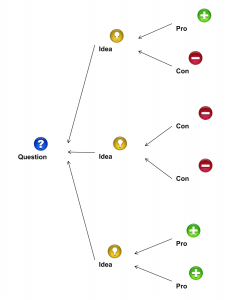This past week, I have investigated Dialogue Mapping and been starting to use it. The context that I first used it in was capturing meeting notes which I could argue the pros and cons of this, but find for virtual meetings particularly interesting and better than most other attempts. The one problem I have found was trying to do it without being the facilitator. One, it is hard to keep up and asking to re-clarifying certain points sometimes seems out of place. It does demonstrate how unstructured most meetings are! 
My new venture with Dialogue Mapping) is to see how it works in a meeting that we are trying to solve a problem and reach a conclusion or an implementation of the countermeasure to the problem. Most of us believe that there is some sort of ideal sequence of events that we go through which results in a decision with the implementation to follow. The preceding discussion to this is quick, direct, and implementation is straight forward. And, that is how it goes most of the time. The issues are familiar, solutions are obvious, and the implementations are straightforward. What I just explained is a routine decision making for a routine problem.
The decision-making process in most organizations are never routine, and more problems seem to exist that we could call messy or as Horst Rittel used to call them Wicked Problems. The bottom line is Tough Problems do not solve easily. This is why the IBIS Method was developed, later followed by Conklin’s Dialogue Mapping. Dialogue Mapping takes these tough problems and structures a way to capture the information. I like the fact that we remove a barrier by doing this, the loss of ideas and questions. The other area, that I see benefit in, is that it allows to control the dialogue to keep all participants in the discussion.
I am not sure for routine discussion, meetings and decisions that I would go through the effort of Dialogue Mapping. I could change my mind as I get more proficient at it. However, I do like the structure of the entire process and can see the benefits of the process for those more difficult decisions.
Dialogue Mapping is based on the Issue-Based Information System (IBIS) method developed by Horst Rittel. The IBIS method breaks a conversation down so that it can be structured into only 3 basic elements: Question, Idea, Pro or Con.
Diagram was created using Rationale Software
